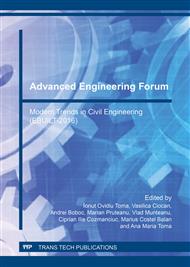p.3
p.15
p.22
p.33
p.37
p.45
p.50
p.58
A Study Regarding Smoke Exhaust from an Atrium Type Building in a Fire Situation
Abstract:
This paper presents the analysis of the effect of smoke exhaust and hot gases from an atrium type building using techniques for numerical simulation of a fire situation. Several scenarios regarding smoke exhaust are considered for that purpose and the variation of the following parameters is monitored: minimum and maximum temperature of hot gases as well as the smoke layer height inside the atrium. Using engineering techniques, the development of fire, in compliance with the European legislation has been modelled, by means of a specialized computer program in order to simulate the phenomena of both the fluid flow and the heat transfer manifested in a fire situation.
Info:
Periodical:
Pages:
15-21
Citation:
Online since:
March 2017
Authors:
Keywords:
Price:
Сopyright:
© 2017 Trans Tech Publications Ltd. All Rights Reserved
Share:
Citation:


